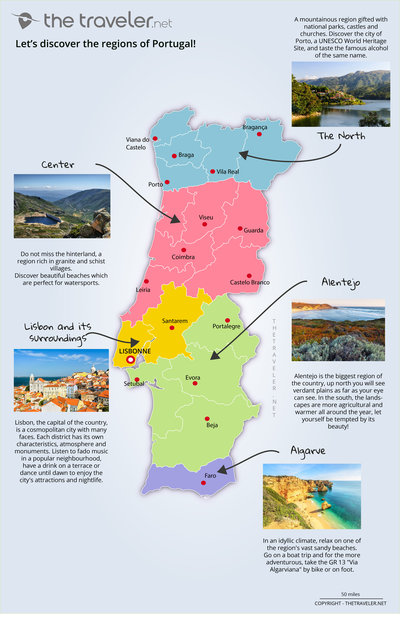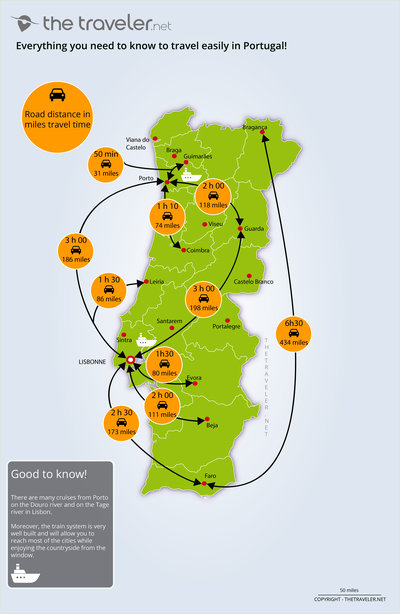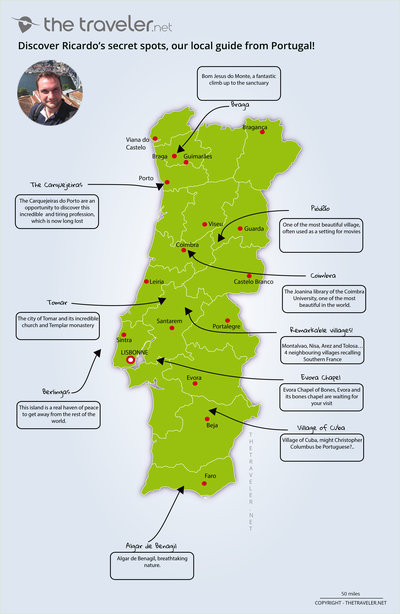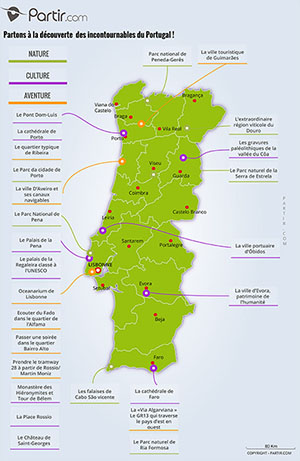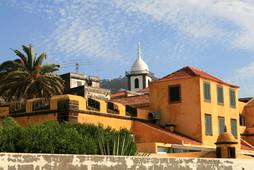Plan an amazing trip to Portugal
The birthplace of Fado music and Porto wine, this ancient Empire of Portugal has a rich historical heritage. Bordered by the Atlantic Ocean, you can admire a variety of different landscapes composed of castles, beaches, small villages, olive groves and vineyards. Tradition combines with modernity to offer travellers both interesting places to visit and countless activities to enjoy.

Ricardo's tips, local guide
Best time to go to Portugal
Portugal is very much appreciated because of its pleasant climate. Summers are not too warm and winters are quite mild. A few climatic differences between the North and South are to be noted though. The Atlantic Ocean influences the climate in the North as it brings rain and humidity. This surrounding humidity lessens as you progressively go inland. Portuguese winters are relatively mild. In Lisbon, minimal temperatures vary from 8°C to 10°C and go up to 15°C during the day. Rain is more frequent during winter time. Up North in Porto, temperatures are a little lower with minimals around 6°C and daytime temperatures going up to 15°C and snow may be seen in the massif de la Serra da Estrela at 2000 meters in altitude where you can ski. In the South, more precisely in Faro, temperatures can go up to 17°C in February. In the spring, rainfalls are less frequent which leaves room for sunshine. Temperatures become very pleasant and reach 20°C or more during the day. It is a good period for visiting the country at a time when the vegetation awakens and becomes a luxurious and colourful décor. Before the arrival of summer, it can go up to 30°C, rainfalls disappear completely. In the North it is always a bit cooler, especially in Porto with recurrent fog in the morning and colder temperatures at the end of the day, pack a jumper for the trip! Autumn is remaining quite pleasant with mild temperatures which can go up to 23°C in Lisbon for instance. Rainfalls are usually back in October. The sea temperature is always fresh in Portugal: 20°C between Porto and Lisbon during the month of August and 22°C in the South. If you're not too sensitive to the cold you can still swim and relax on the most beautiful beaches of Portugal. If you are planning a trip to Portugal, we recommend the period between May and September, it's the period when temperatures are the most enjoyable and when the rain is almost non-existent. If you wish to swim, July and August are the perfect months, especially in the South but be careful as it's quite crowded during the summer. For a trip to the North, discover when to go to Porto.
What to see and what to do in Portugal
Ricardo answers your most frequently asked questions
If you decide to go to Porto with your family, here is what I 'd suggest: The first two or three days, just wander around and discover this historic and authentic city, take a look at the river, ocean, parks, nightlife, culinary specialities etc....A guided tour at the beginning of your stay will help you to grasp the authenticity of the city. Then, rent a car to go to Guimarães and visit its castles. On another day, you can go to the Douro Valley, to admire its breathtaking landscapes. Don't miss out on the opportunity of a boat trip, it's possible to take a day cruise up the river from Porto, which is extremely pleasant for families. Why not go to Aveiro? Our little Venice, as we call it, it's the perfect area for a stroll in the streets and by the canals. Even if time will seem to go by too quickly, don't worry, you can always come back again for another trip and new adventures such as going to our mountains, swimming in the crystal clear waters of our small rivers, hiking, surfing in the ocean, camping, or participate in countless village festivals, etc....
Throughout the country, there are places where both nature and beauty are preserved, and where both humans and nature live in perfect harmony. Protected to maintain their biodiversity, many of these regions are classified as parks and nature reserves, among others, you can find for example the beautiful Peneda-Gerês, the Parque Natural do Alvão, the Douro Internacional, Albufeira do Azibo and of course the Serra da Estrela.
I think the beaches in Southern Portugal are the best! However, it's important to keep in mind that the temperature of the water in Portugal is much chillier than in the Mediterranean sea. The ocean and currents are quite cool. In the South, in the Algarve region, the beaches are beautiful and more suitable for swimming. However, because it's a very touristic area, be aware that there are a lot of crowds in the height of the summer.
Portugal has very similar driving standards to other European countries. Traffic regulations are the same, even if there are no apparent roadsigns of radars on the sides of our roads it doesn't mean that there aren't any radars from time to time. Ground markings on the STOP and YIELD lines are not easily visible from a distance, which can prevent anticipating when to stop or yield right of way. The speed limits are similar with a maximum of 75 mph (130 km) on the motorway. However a more notable difference is the toll system on our highways. In fact, in Portugal, many motorways have opted for an automatic toll system, i.e. without tickets, without payment by credit card or cash. Locals have a recognition box or bip in their car that activates a direct bank debit when they pass through "toll gates" which have a whole range of different reading technologies, such as radars. Visitors are advised to check this out with their car rental agencies. If they travel with their own vehicles, the border areas have provided adequate information and payment points to ensure that they can travel without any trouble in Portugal.
To listen to Fado music in Lisbon, I strongly recommend "Clube do Fado" and "Tasca do Chico".
There is so much to see in Lisbon, such as Belém, Bica, Mouraria, Alfama.. Which are real must-sees to grasp the Portuguese way of life, and places with a lot of charm and authenticity. I strongly recommend tasting the renowned Pasteis de Natas de Belém during your stay.
Portugal offers a multitude of activities for everyone. During a family trip, you need to try and balance different activities: visits to emblematic monuments of the country and recreational activities for children. For instance in Porto, you can climb the Clerigos tower, cross the Luis I Bridge, go on a mini cruise. A bike ride along the Douro with your family is very pleasant, as would be a walk to the Jardim du Palácio do Cristal. A nice walk by the ocean is a pleasant way to end your day with a touch of relaxation. The artisanal ice-cream will delight even the youngest during your stay in Portugal. For watersports enthusiasts, a multitude of nautical activities is available. In Lisbon, discover the Oceanário de Lisboa, the Jardim Zoológico, or the Belém tower.
Portugal is a country with many extraordinary products. In my opinion, Portuguese wines are the best products to bring home: Porto wines and Vinho Verde are the most famous vintages. But don't forget to taste Ginja in Lisbon which is also exquisite. Talking of wine, it's important that you should know that you will need to check in your luggage if you are travelling by plane, as it is not allowed to carry alcohol in your carry-on bags. Apart from wine, Portugal is the world's largest producer of cork oak and therefore cork products from which Portuguese craftsmen manufacture a variety of different products. Portuguese craftsmen manufacture multitudes of varied products with surprising materials. You might come home with glass, paper, wooden made products, or why not come back with a painting, an engraving, a drawing done by one of the many artists present in our cities to remind you of your holidays in Portugal once you return home.
Portuguese cuisine is rather varied and each region has its own particularities. It would be too long to list every dish, but here are some of the most popular: In Porto, it is almost mandatory to taste the Francesinha and the tripes, which are representative dishes of the city. The Francesinha is available in all restaurants, it’s a sort of croque-monsieur, filled with meat, sausages, ham and covered with cheese and a spicy tomato and a beer sauce. In the South, in Aveiro, eels and a small cake called Ovos Moles are regional dishes. Even further south, in Mealhada, it’s the suckling pig (Leitão). North of Porto, it’s an incredible festival of varied dishes, where you will find dishes such as Arroz de Sarrabulho, Rojoes, Arroz de Cabidela.. Inland, Portugal offers extraordinary kinds of different meat, such as the Barrosã steak, the Cabrito or the Anho Assado. In Lisbon you can taste the famous Pastéis de Nata, a small pudding served with cinnamon and icing sugar, selected as being part of the top 50 best dishes in the whole world by The Guardian! And finally, as Portugal is a coastal country, you will have plenty of different choices when it comes to fish. In other words, if you take into account the cost of food which is quite cheap, you definitely shouldn't go to Portugal to go on a diet.
- The chilly temperature of the Atlantic coast water.
The mild climate and the kindness of its inhabitants. In addition to this, the country has a wide variety of different landscapes that allows everyone to admire nature and discover its rich biodiversity. The country has famous seaside resorts in the south of the Algarve, but also, further afield, in its Azores islands and in Madeira. Finally, its proximity to most European countries makes it a relatively affordable destination.

